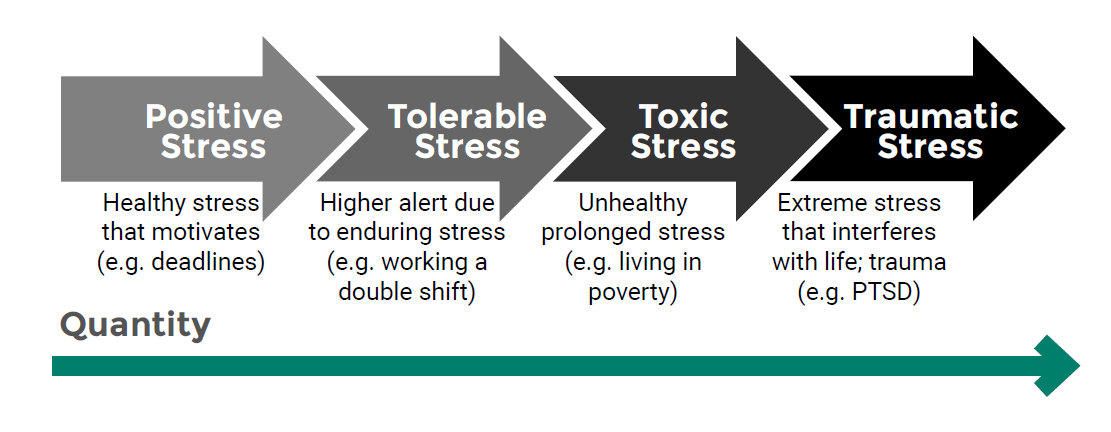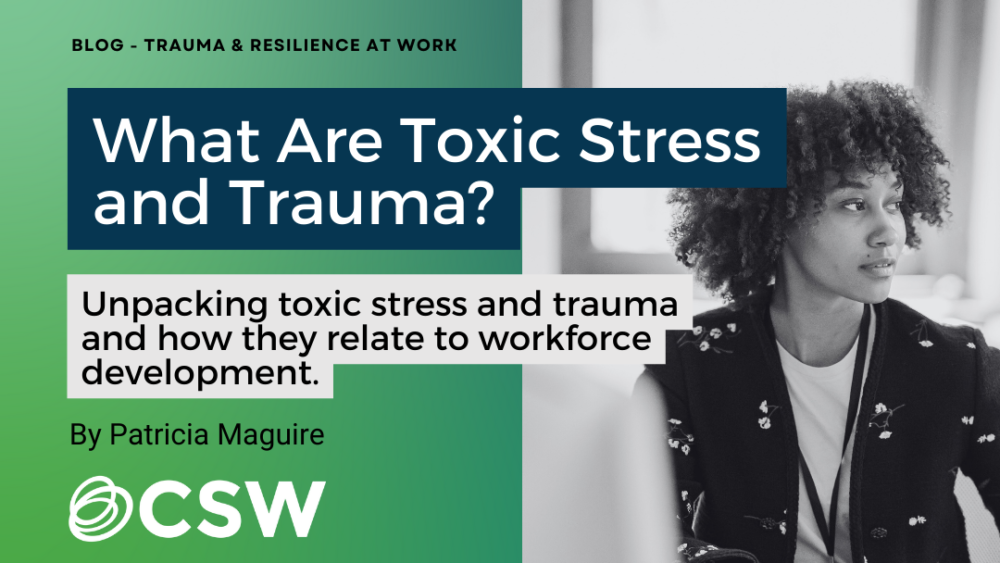Unpacking toxic stress and trauma and how they relate to workforce development.
Toxic stress and trauma are unfortunately common experiences, affecting many individuals’ abilities to succeed in education, employment, and life at large. Recent studies show that 60-70% of adults have experienced at least one one of the most common types of traumatic experiences, adverse childhood experiences (ACE). Individuals with two ACEs are 1.5 times more likely to have job problems, 1.4 times more likely to be absent from work (2 out of 30 days), and 1.8 times more likely to have financial problems. These risk rates increase with the number of ACEs a person has, and they represent only one type of trauma.
Defining Trauma
CSW uses the definition of trauma from the U.S. Substance Abuse and Mental Health Services Administration (SAMHSA), which takes a holistic approach to defining trauma, its causes, and its effects:
Trauma is an event, series of events, or set of circumstances that is experienced by an individual as physically or emotionally harmful or life threatening and that has lasting effects on the individual’s functioning and mental, physical, social, emotional, or spiritual well-being.
Trauma floods our brains with cortisol, the emergency response hormone. A “trauma brain” is always scanning for and reacting to danger, rather than engaging in learning and other executive functions. While we cannot predict the impacts trauma may have on a person’s life, we can identify ways in which trauma may affect a person and predict longer term consequences if trauma is left unresolved. Brain science has shown that trauma rewires our brains, which can cause us to be anxious, depressed, angry, or avoidant, depending on the individual. Studies are increasingly showing a link between traumatic childhood experiences and a greater chance of physical and behavioral health problems in adulthood. Lifelong health problems may include chronic lung and heart diseases; autoimmune diseases; anxiety, depression, and headaches; high blood pressure; digestive issues, and more. Recognizing trauma provides an opportunity to combat those trauma symptoms by implementing resilience-building strategies.
Different Types of Trauma
There are several different types of trauma which are not mutually exclusive; one individual could experience multiple types of trauma in the same period of their life. The below framework was developed by Dr. Jessica Camp, Social Work Data, based on Dr. Nadine Burke Harris’ The Deepest Well: Healing the Long-Term Effects of Childhood Adversity and Vedat Sar’s Developmental trauma, complex PTSD, and the current proposal of DSM-5.

Secondary or Vicarious Trauma
Secondary Trauma occurs when individuals respond to trauma experienced by others, sometimes also referred to as “compassion fatigue”. For instance, a Career Coach working with a domestic violence survivor may “absorb” the trauma experienced by this customer as they describe their situation. The Career Coach may experience their own physical or mental trauma symptoms just as the domestic violence survivor experienced theirs, i.e., depression, anxiety, hypervigilance. Another example might be a teacher supporting a student who’s housing is unstable, running the risk of needing to leave school mid-semester as a consequence.
While empathy is a cornerstone of supporting others in their healing journey, it’s essential to establish healthy boundaries and self-care practices to prevent the unintentional absorption of another person’s trauma. This can affect one’s own well-being and resilience. In doing so, we ensure that our empathy remains a source of strength and support rather than a potential source of secondary trauma.
Organizational trauma
Organizational Trauma occurs when individuals who work in high stress environments, such as hospitals during the COVID-19 pandemic or first responder organizations, experience secondary trauma on a regular basis and the organizational structure and culture become negatively impacted as a result. Toxic workplaces that are regularly full of negativity, discouragement, and/or disrespect are another example of organizational trauma. Unaddressed organizational trauma, whether sudden or cumulative, might lead to high staff turnover rates and a weakening of the organization’s ability to respond to internal and external challenges.
Acute Trauma
Acute Trauma is a single, time-limited, traumatic event that threatens an individual’s physical or emotional safety. Examples include a car accident, physical or sexual assault, witnessing an assault, sudden death of a loved one, and mass shootings.
Chronic trauma
Chronic Trauma is repeated exposure to harmful events or experiences over a prolonged period of time. Examples of chronic trauma include experiencing persistent neglect, bullying, abuse (emotional, physical, or sexual), domestic violence, poverty, homelessness, chronic medical illness and procedures, and community violence.
Complex or developmental trauma
Complex Trauma is when multiple traumatic events occurs over the course of an individual’s life, including some acute and/or some chronic traumatic events. This is the greatest amount of individual trauma a person can experience and because of the multiple exposures, may be more likely to alter and impact the individual’s personal or professional life. An example is an individual who experiences multiple Adverse Childhood Experiences such as neglect, racial trauma, poverty, and community violence.
Collective trauma
Collective Trauma are traumatic events that impact an entire society. Collective trauma does not only represent a historical fact or event but is a collective memory of a traumatic event that happened to a group of people. Examples include the coronavirus pandemic, 9-11, the Holocaust, systemic racism, police violence, and catastrophic floods, fires, hurricanes, tornadoes and other major weather events. Collective trauma can not only have an impact on individuals, but it can also change the entire fabric of a community, impact relationships, and alter social norms and government policies.
From Positive Stress to Trauma
The typical adult experiences some type of stress in their personal and/or professional daily lives. When we look at the role of stress in people’s lives, there are two things we look for: the amount (or quantity) of stress experienced and the severity of the stressful event(s). As severity and quantity increase, the chances of experiencing the adverse effects of stress also increase.

Stress can be a positive experience, helping to motivate us. For example, preparing for a conference presentation: stress motivates us to put our best foot forward and strive to deliver an informative and thoughtfully prepared session. As stress increases, we move into a space where the stress is uncomfortable but tolerable, knowing that this particular stressor will end when the conference presentation ends. There may still be other work projects needing our attention (additional deadlines, other deliverables to complete), and it is stressful juggling all of this, but tolerable.
As we go up the stress scale, we move into unhealthy levels of stress. Stress becomes toxic, disruptive, and longer lasting. The conference presentation example is a single event added on to normal responsibilities. But think about having a more consistent workload that exceeds your bandwidth. This is where you may begin to feel overextended and struggling to manage competing deadlines.
Ultimately, toxic stress can become traumatic stress. Going back to the definition of trauma, this is when stress begins to interfere with our daily functioning and mental, physical, social, emotional, or spiritual well-being. For example, we may develop chronic sleep problems, irritable bowel syndrome, depression, or other mental and/or physical health conditions. It is at this level that we stop calling it stress and start calling it trauma to denote the degree to which coping mechanisms become overwhelmed.
How Trauma and Toxic Stress Show Up in Workforce Development
Certain situations and stimuli can trigger responses that may be harmful and can manifest in many contexts, both in our work and personal lives. Because toxic stress and trauma bypass our “thinking brain” and go straight to the fight, flight, freeze, or submit part of our brain, the trigger takes this same “fast pathway”. In other words, triggers make individuals react as if they are in danger. Trauma responses include getting defensive and pushing back, abruptly quitting a job or program, becoming verbally unresponsive, and/or depression, among others.
What can we do about trauma and traumatic stress? Although most of us are not trained mental health professionals (and should not try to adopt a clinical role), there are many practices and strategies we and our organizations can adopt on a daily basis that don’t require clinical training or take a lot of time or money to be more trauma-informed and resilience-building and have a positive impact. For example, the BEAM Collective’s five step LAPIS Model lays out what to do when presented with someone exhibiting possible signs of toxic stress, trauma, or re-triggering. L = listen and assess for distress or harm. A = affirm their experience. P = partner with them to navigate care. I = initiate self-care and support plan. S = seek out help as needed. In addition, SAMHSA has six guiding principles to help staff and organizations adopt trauma-informed and resilience-building practices: safety; trustworthiness and transparency; peer support; collaboration and mutuality; empowerment, voice, and choice; and cultural humility and responsiveness.
CSW’s Trauma & Resilience at Work team developed a four-part series which further details resilience-building strategies to manage toxic stress and trauma, particularly in the workplace. You can download a free copy of of the series and begin learning methods for managing trauma and stress in your own life and workplace.

Meet the Author
Patricia Maguire
Patricia is a Senior Policy Associate with CSW’s Trauma and Resilience at Work team. The CSW Trauma and Resilience at Work team advances workplaces and workforces that are culturally responsive, trauma-informed, resilience-building, and supportive of mental well-being. Continue reading >>



Comments are closed.